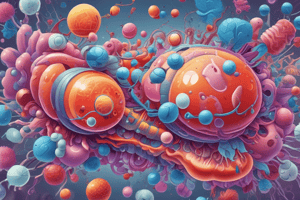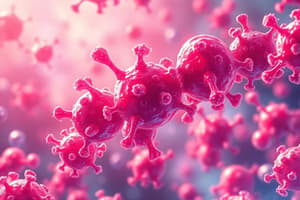Podcast
Questions and Answers
Which antibiotic targets the 30s ribosomal subunit?
Which antibiotic targets the 30s ribosomal subunit?
- Linezolid
- Erythromycin
- Chloramphenicol
- Gentamicin (correct)
What is the mechanism of action of tetracyclines?
What is the mechanism of action of tetracyclines?
- Disrupting the growing peptide chain
- Inhibiting protein synthesis by a unique mechanism
- Halt peptide chain elongation (correct)
- Inhibiting the addition of new amino acids
Which antibiotic is effective against intracellular pathogens, such as chlamydia, rickettsia, and rickettsia-like organisms?
Which antibiotic is effective against intracellular pathogens, such as chlamydia, rickettsia, and rickettsia-like organisms?
- Tetracyclines (correct)
- Linezolid
- Clindamycin
- Glycylglycine
Which group of antibiotics includes erythromycin, azithromycin, and clindamycin?
Which group of antibiotics includes erythromycin, azithromycin, and clindamycin?
What is the mechanism of action of chloramphenicol?
What is the mechanism of action of chloramphenicol?
Which antibiotic is a derivative of the macrolides?
Which antibiotic is a derivative of the macrolides?
What is the mechanism of action of aminoglycosides?
What is the mechanism of action of aminoglycosides?
Which antibiotic is effective against both gram-positive and gram-negative bacteria?
Which antibiotic is effective against both gram-positive and gram-negative bacteria?
What is the mechanism of resistance to beta-lactam antibiotics?
What is the mechanism of resistance to beta-lactam antibiotics?
Which antibiotic is often not used due to its toxicity?
Which antibiotic is often not used due to its toxicity?
Flashcards are hidden until you start studying
Study Notes
Principles of Antimicrobial Action and Resistance
- Antibiotics are chemical compounds that kill or inhibit the growth of infectious microorganisms.
- Antibiotics must be in an active form, and the route of administration and intended site of action must be considered.
Inhibitors of Cell Wall Synthesis
- The bacterial cell wall, composed of peptidoglycan, confers structural rigidity and shape.
- Beta-lactam antibiotics interrupt cell wall synthesis by binding to transpeptidases.
- Bacteria have developed resistance to beta-lactam antibiotics by producing beta-lactamases.
- Three beta-lactamase inhibitors (clavulanic acid, sulbactam, and tazobactam) can bind beta-lactamase.
- Glycopeptides (e.g., vancomycin and teicoplanin) bind to precursors of cell wall synthesis, blocking access to transpeptidases.
Inhibitors of Cell Membrane Function
- The cytoplasmic membrane surrounds the bacterial cell, functioning in enzyme synthesis and secretion, energy gradient formation, and metabolite retention.
- Polymyxins (e.g., polymyxin B and colistin) act on the cell membrane, causing intracellular material leakage.
- Daptomycin is a lipopeptide that binds and disrupts the cell membrane of gram-positive bacteria.
Inhibitors of Protein Synthesis
- Protein synthesis can be disrupted at the ribosomal level by antibiotic binding to the 50s or 30s subunit.
- Aminoglycosides (e.g., gentamicin, tobramycin, amikacin, and streptomycin) bind the 30s ribosomal subunit, interfering with translation.
- Macrolide-lincosamide-streptogramin (MLS) group (e.g., erythromycin, azithromycin, and clindamycin) binds receptors on the 50s ribosomal subunit, disrupting peptide chain growth.
- Ketolides (e.g., telithromycin) are derivatives of macrolides, inhibiting protein synthesis.
- Oxazolidinones (e.g., linezolid) inhibit protein synthesis by a unique mechanism.
- Tetracyclines halt peptide chain elongation, having a broad range of activity against intracellular pathogens.
- Chloramphenicol inhibits the addition of new amino acids, effective against a wide range of bacteria.
Resistance to Beta-lactam Antibiotics
- Bacterial strategies that mediate resistance to beta-lactam antibiotics include enzymatic destruction of the drug, altered targets for the antibiotic, and decreased cellular uptake of the drug.
Studying That Suits You
Use AI to generate personalized quizzes and flashcards to suit your learning preferences.



